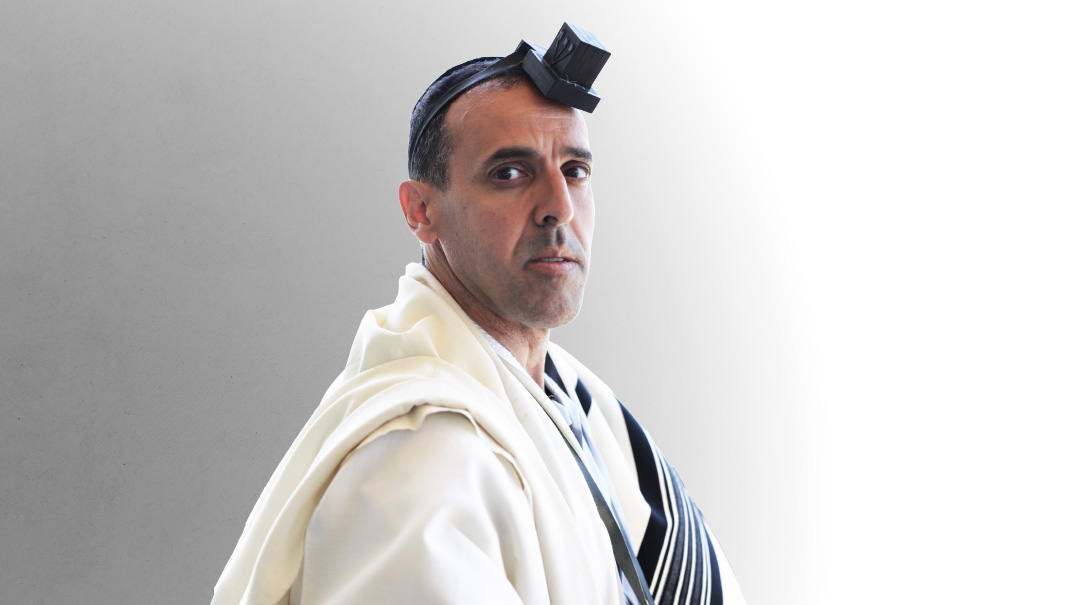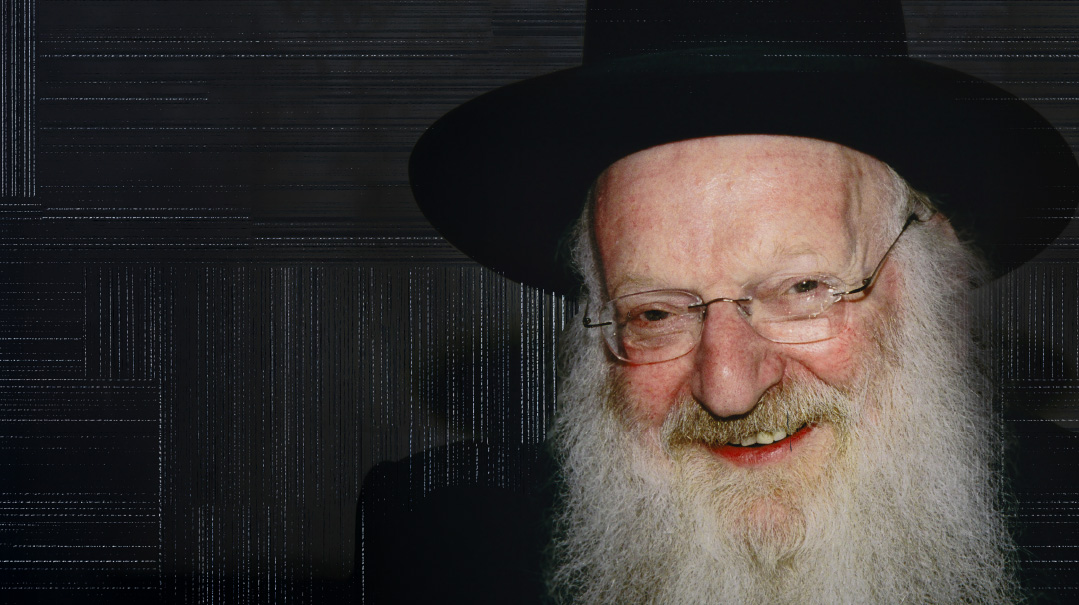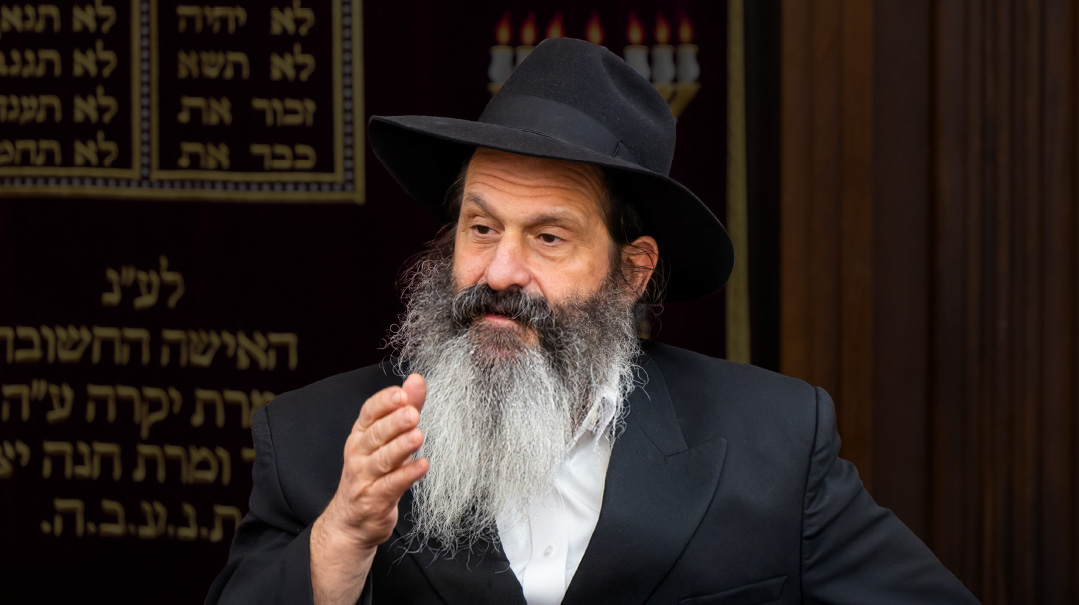Choose Life
| June 10, 2025Chained in a Hamas dungeon, freed hostage Eli Sharabi knew he was never truly captive

Photos: Elchanan Kotler, Menachem Kalish
Eli Sharabi didn’t choose the massacre, didn’t request that his family be slaughtered, and didn’t ask to be kidnapped. But there was one choice he knew he could still make, even as he was doubled over in pain, chained and shackled, deep in the bowels of a Hamas dungeon. He could stand on the side of humanity, compassion, and faith, and when that happened, he knew he was never truly captive
Four hundred and ninety-one days — of hope buried dozens of meters underground, in the shadow of the dregs of humanity. Of waking up every morning to an unfathomable reality. And then, an entire nation watched as hostage Eli Sharabi returned to an excruciating present of pain and loss.
But whoever thought that Hamas’s cynical stage — where Eli Sharabi was forced to accept some “souvenirs” in advance of his release on February 8 — would frame the freed hostage’s future, it turns out that the Eli Sharabi we meet this week is far from broken. And the more we learn about the vast pain and grief he has endured, the greater the admiration for the spiritual strength, determination, gratitude, and forward-focused perspective of this eternal optimist.
Sharabi, 53, was abducted from his home in Kibbutz Be’eri on October 7, 2023, during Hamas’s onslaught. His wife, Lianne, and daughters Noya, 16, and Yahel, 13, were murdered soon afterward. His brother Yossi was also kidnapped and later murdered by his captors, who are still holding his body.
Sharabi only found out about the murder of his family after stepping into the Red Cross vehicle that would finally take him to safety. “I imagined my wife and girls running to me,” he says of one of his most shattering moments. “But of course, that didn’t happen. Still, I’m glad I didn’t know they were dead. Because thinking that I would return to them is what kept me going through every horrible day in captivity.”
In the four months since he’s been free, the people of Israel and beyond have gotten a glimpse of Sharabi’s extraordinary inner resilience. This is a man who emerged from gehinnom into the greatest grief imaginable and chose to continue living with vigor, faith, and optimism. He moved hearts when he spoke of how his connection to G-d sustained him in captivity — how he recited the Shema, how he made Kiddush on Friday night inside the horror, and how, despite excruciating hunger, he refused to read verses from the Koran in exchange for a little extra food.
“Everything in life is a choice,” he explains, offering all of us a glimpse of the mindset that allowed him to survive under the bleakest conditions and still make every day meaningful. “You know, from the moment I was free and realized my loss, I could have sunk into despair and just let the grief consume me. I could have chosen to stay under the covers all day and cry. But where would that have gotten me? It certainly wouldn’t have given me the strength to move forward. Instead, I look for places that give me strength, and I find that strength in family, in friends, in faith, in putting on tefillin every morning. And I’ve chosen to live again.”
It’s Your Choice
Eli Sharabi, whose book Hostage — an accounting of his hundreds of days in the tunnel network, just released by Sela Meir Publishing — is the first real-time account of life in captivity by a released hostage. The emaciated body that we all saw standing on that Hamas platform after a year and a half of being shackled in iron chains, stands in stark contrast to the man now sitting here on the couch in a well-appointed Herzliya apartment. Today Sharabi has embarked on a public journey of choosing life anew every day, through faith, optimism, and hope. Since his release, he’s met with presidents and spoken on international stages — even US President Trump wiped away a tear when the two met in the Oval Office.
Eli Sharabi, who had been living on Kibbutz Be’eri since he was a teenager, married Lianne, a British citizen who had come to Be’eri as a volunteer at 19 and went on to work in a dental clinic. His brother Yossi Sharabi joined him on the kibbutz, married Nira, a nurse, and for decades the two families lived next door to each other. Eli worked as the community’s treasurer before becoming a financial manager of several companies outside the kibbutz, while Yossi worked at Be’eri’s printing press.
On a physical level, Sharabi completely lost control over his quiet, idyllic life on Simchas Torah 2023. From the moment Hamas terrorists stormed his home, tore him from his wife and daughters, and dragged him into a tunnel beneath the earth — nothing, seemingly, was in his hands. He needed permission to eat; he needed permission to use the bathroom, which was a complicated process as he was shackled; he was constantly beaten; he had to make do with a half-bucket of cold water for a shower once a month; and with a tenth of the calories a human body requires.
But Eli Sharabi was never truly captive. Because while his body was imprisoned, he constantly preserved his freedom to choose: to choose humanity, compassion, faith.
“Of course,” he says, “I didn’t choose to be kidnapped. I didn’t choose what happened in the massacre. But I always chose how to respond, what to hold on to. And most importantly, how to remain a human being, even in captivity. Even when they’re torturing you, even when there’s no food. Even when you crave just one more crumb, you have to know how to stay human. So in truth, you choose. You are constantly choosing. Even in a situation of no control, you create a measure of control through the choices you make.”
Sharabi’s captivity was indeed filled with choices — like his choice not to fight back when ten terrorists stormed into his home in Kibbutz Be’eri. A choice he hoped at the time would help save his wife and daughters. And even though during captivity he knew there was a chance that they had not survived, he kept choosing life — moment by moment — in an impossible reality.
“In the end, everything is a matter of choices. In every situation, you choose, on some level or another. You choose to lower your head when they humiliate you, not to answer back, because otherwise they might harm you. I never looked at death as an option. I always chose life. And when you become aware that it’s always you choosing, those choices also return a certain level of humanity to you. Even in those places, you can generate that humanity, you can find your inner point of choice.”
No Magic Formula
Sharabi was first held alongside a Thai worker and for over a year with fellow Israeli hostages Alon Ahel, Eliya Cohen, and Or Levy (he was released together with Or Levy and Ohad Ben-Ami, while Alon Ahel remains in captivity). For a time, the group found themselves alongside Ori Danino and Hersh Goldberg-Polin, who were later murdered by their captors in August 2024.
Eli Sharabi, the oldest in the group, quickly became something of a leader, a source of strength and comfort, especially for Alon Ahel, whom he took under his wing. Sharabi says that leaving him behind was heart-shattering.
“Alon was kidnapped from a bomb shelter,” Sharabi relates. “He was hit by shrapnel in his right eye and lost his vision. I’m 53, he’s 24. I assumed I’d be released before him, and from the beginning, I knew I had to give him tools to cope, so that he would know he has the capability to survive.”
Eli’s surviving brother, Sharon Sharabi, became a relentless face of advocacy for the hostages. While he knew that Yossi was dead, he held out hope for Eli’s survival. In his yarmulke, radiating emunah, he kept saying, “Eli chazak, Eli is a leader, a hero.” But here, in this Herzliya apartment, with characteristic modesty, Eli Sharabi himself doesn’t really think those titles represent him. It’s more, he says, about life experience.
“I saw the difference in the tools I had compared to the younger fellows who were with me in the tunnels,” he says. “Maybe the life I lived gave me certain tools that allowed me to endure the captivity with greater mental resilience. I remember telling the younger ones who were with me, ‘We’re at zero ego. We have one mode: survival. We need to get back to our families. Nothing else matters.’ That’s the whole story. And I pray every day that Alon, who was with me for a year and two months, 50 meters underground, is managing to apply that now, on his own.”
I ask Eli if he often thinks about October 6, when his life was calm and orderly. What would he do differently if he knew what the next day would bring?
“I wish there were some kind of magic formula that could grant you just a few more minutes with your loved ones,” he says. “Because in the end, you realize that that’s what really matters. Underground, you don’t miss your big house, your car, your bank account. You miss your family. Your friends. You miss people. You don’t long for material things — you long for memories, for laughter, for experiences, for a hug. Maybe I didn’t hug my daughters enough. Oh, what I would give for one more hug. For one more minute with my wife, telling her how much I appreciate her. Or one more moment with my brother. I wish there were a magic formula….
“I used to be a financial manager, with a degree and professional accomplishments. But today, I understand that it’s people who give my life meaning. I understood it during captivity. To be there for others. To guide. That’s where meaning lies today.”
Living with Gratitude
Sitting with Eli Sharabi over a cup of tea, it’s hard to believe that just three months ago he was living in an alternate universe, only to emerge into the harsh reality of bereavement and loss. How does someone who was chained in iron shackles in a tunnel for sixteen months look at the world where the sun shines?
“Every action that seems most basic to us, like getting out of bed, walking down the street, or eating a slice of bread, is not basic at all when you’re a person who isn’t free,” he says. “The physical conditions were very harsh. No hygiene, constant humiliation, violence, shackled at the legs 24/7, broken ribs, iron chains cutting into your flesh. But even with all that, nothing bothers you like hunger. When will the next meal come? Even the tiniest crumb becomes an event. What you wouldn’t give for another half a pita. But faith and hope are what lift you above all of it, above the physical things. And that was something we didn’t miss — not a single day. We got up, we prayed, no matter what. And so all of life takes on a different meaning. The gratitude becomes something else.”
Eli Sharabi, a big fellow who weighed just 44 kilo upon his release, is someone who lost everything most precious to him, and still doesn’t stop giving thanks. A man who faced the depths of human evil and still chooses to focus on gratitude.
“Well, even fifty meters underground, I always had hope,” he stresses. “I remember telling the younger ones with me: ‘You can break down. You can cry. But you must not lose hope.’ For me, it was clear that I would survive this, that somehow, I would get out. Maybe in a month, maybe in two, even if it would take a year, it didn’t matter. And we stayed connected through the emunah that every Jew has deep down — whether it was through saying Shema Yisrael together, or the morning brachot that Elya knew because he’d grown up religious, or the Friday night Kiddush. We made sure to keep aside a quarter of a pita for Hamotzi on Shabbat, and on Motzaei Shabbat we would sing the Havdalah songs that I remembered from my parents’ house.
“I’m not a religious person,” Sharabi continues, “but this world isn’t foreign to me. I come from a traditional family. A lot of my childhood was spent in the beit knesset, in Shabbat and holiday prayers. On the kibbutz, we didn’t keep Shabbat in the classic sense, but every Friday night I would make Kiddush with Lianne and the girls, and we always joined Yossi’s family for a Shabbat meal.”
In the tunnels, those traditional spaces gave him strength. “Even in the early days of captivity,” he says, “I found myself murmuring the Shema over and over again — not thinking about the meaning, just repeating it like a mantra that seemed to surround me with protection. And every morning, Elya would recite the morning brachot by heart, which he remembered, and the rest of us would say Amen after each one. That’s how we would start every day. And then, no matter what we’d been through during the week — what arguments we had or didn’t have, what frustrations, what sorrow, what pain — no matter how we looked, how our space looked, how the toilets looked, what the air felt like, when we last ate or what we last ate, no matter how much darkness surrounded us, we’d gather and listen to Elya as he held a cup of water and recited ‘Yom hashishi….’
“Before Kiddush, I would sing Eishet Chayil, thinking about my mother, my sisters, Lianne, Noya, and Yahel — hoping they were alive and safe. At the end of Shabbat, Elya would sing the Motzaei Shabbat songs he knew and we would join in. A lot of those songs I remember my father singing, and it gave me strength and a feeling of connectedness — connected to the Jewish People, to identity, to tradition, to my childhood, to my roots. It reminded me of my father, a white tallit during Shabbat prayers, the aron kodesh opening, a sefer Torah, a chazzan’s voice rising in song, a white cloth spread over the table. Everything that was so, so far away from where we were.
And then I’d imagine my homecoming — my mother, my sisters, my brothers, Lianne, the girls. The hugs. I would picture the people I love most, surrounding me in light, whispering: Shabbat shalom, Eli. Shabbat shalom. We’re so glad you’re back.”
(Originally featured in Mishpacha, Issue 1065)
Oops! We could not locate your form.







